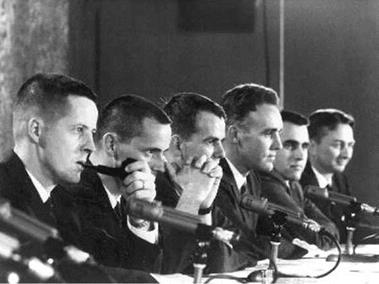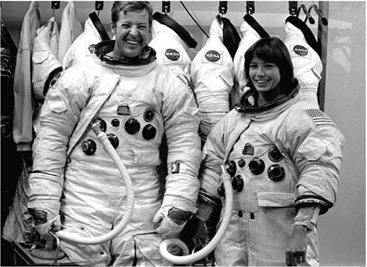Selecting new astronauts
For NASA, a second Skylab could also have helped the transition from the Apollo era to the Space Shuttle era and given some of the veteran astronauts remaining in the office an opportunity to fly and to pass on their skills and experiences to the Shuttle era selections. Unfortunately, this was not to be. Some members of the original NASA astronaut selections faced a wait of over seven years from the end of Skylab to the first Shuttle mission, with only the 1975 ASTP mission flown in that period. For some, this was much too long to wait and they left the program to pursue other goals, taking their experience with them.
But in 1978 the first NASA astronaut selections in a decade did bring in the first female and monitory astronauts to the team. Things were certainly changing as the decade drew to a close. The “original” four NASA pilot astronaut selec-
|
The first scientist-astronauts (left to right): Kerwin, Gibson, Michel, Graveline, Schmitt, and Garriott, in 1965. |
|
The changing era, Skylab scientist-astronaut Joe Kerwin with Shuttle mission specialist candidate Anna Fisher. |
tions, and former MOL astronaut transfers, in the 10 years between 1959 and 1969 were drawn from those with experience of military or civilian jet and test pilot roles. This reflected the need for the “flying” skills thought to be beneficial to the Mercury-Gemini-Apollo series of missions. As the nature of the missions evolved from the pioneering steps, so NASA brought in two groups of “scientist astronauts” to train for later missions on Apollo and AAP (Skylab). Their backgrounds were more academic than operational flying, but they still all had to qualify from a military jet pilot course to be assigned to Apollo era missions. For some this was a qualification too far and they left the program without flying in space, while others adapted well in gaining new flying skills. Four of the scientists flew between 1972 and 1974, while others performed backup and support roles on Apollo and Skylab. But they still had a long wait to fly on the Shuttle.
By the late 1970s, the scientist astronaut designation had changed briefly to senior scientist astronaut before eventually becoming the mission specialist designation that would become familiar in the new Shuttle program crewing policy. But the name wasn’t the only change, as the role was now widened to encompass a broader range of skills and education. A greater diversity of specialists and qualifications were now considered acceptable for astronaut selection, encompassing engineering, pure and applied sciences, alongside operational accomplishments and new technologies.
Jet pilot training was now no longer a prerequisite. In fact, NASA reasoned that past experiences and qualifications served to demonstrate a candidate’s ability to learn, so they assigned each new astronaut selection into a basic astronaut training program. It soon became evident, in the ongoing mystery of NASA flight crew selection, that being a professional astronomer did not lead to a flight on Shuttle astronomy missions; neither did qualification as a medical doctor guarantee automatic assignment to a medical mission. Such qualifications did increase the chances of such an assignment as the program unfolded, however. Unlike the early selections to NASA’s astronaut program, who were designated “astronaut” from the first day, those selected from 1978 only received the designation after completing the Astronaut Candidate (ASCAN) training program.












